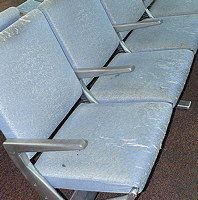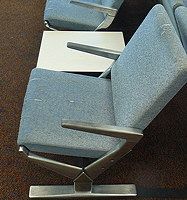

Curaçao International Airport
Hato Airport started with the historic flight of the Snip, which also started KLM's West Indian operations,
finally stranded in the dismal bankruptcy of DCA, Dutch Caribbean Airlines.
In 2003, the Antillean government signed an agreement with Alterra to develop and maintain Hato airport together with Curinta (Curaçao International Airport) as CAP, Curaçao Airport Partners.
Arrivals & Departures
These links were here but they mostly don't work, what's the use.
 Alterra was a joint venture of Shanghai Airport and Bechtel Enterprises. |
| For a very long time, Hato Airport had been planning rebuilding and renovation. Much work was done in carefully planned stages by architectures of Plan D2. Both departure and arrival halls had been extensively renovated, awaiting a new building for which plans were ready. Building of access roads was proceeding, the last stage before starting of actual building. At that point, in 2003 Curinta (Curaçao International Airport) was suddenly incorporated in CAP (Curaçao Airport Partners), in which Alterra had shares. CAP was supposed to manage the airport for a period of thirty years. A similar contract for Costa Rica's Juan Santamaría airport turned into 'a long-running drama' when the Contraloría General de la República, a financial watchdog comparable to our Rekenkamer, saw cause to void Alterra's contract three times. When it was announced that all old plans would be discarded a wave of discontent started among Curaçao architects. In something like a month, Alterra had finished designing a new building (nobody liked it but that's not only because it's expectable) and all. Total planned costs ANG80M. Alterra started building right away - but many people who worked on the new airport design before then will have to prosecute to get the money Curinta owes them. Investments totaling ANG30M have just been thrown down the drain. Alterra had a lot of hot air to blast. They were firmly dedicated to making the airport the Pride of the Caribbean... an international hub... blah blah. We take a long-term approach through our equity investment in our airport assets, affirming our commitment to quality, efficiency, and service.Then, out of the blue, in August 2005 Alterra suddenly announced they wanted to sell their shares, something that they were not even allowed to do for the first five years. An airport executive declared this was nothing unusual... not to worry, folks. One year after their announcement, this was still on one of their web sites (now defunct):\ Curaçao International Airport (Netherlands Antilles)There are rumors that Alterra is leaving because they fear political instability (as well they might); but judging from the way they came here, bad politics are grist for their mill. Another general feeling is that Alterra and their friends have made their pile of dough and now don't have time to be bothered any more. Let's quote them again: |
Our philosophy is to operate airports in true partnership with the community |
(keep this in mind while you read what follows)
On December 1, 2005, two bookshops of Hato airport announced their closing down, blaming this on the very much higher rents, raised by CAP (40% with 6 months retrospective effect), without any discussions with renters; ten people have lost their jobs.
90% of Hato companies have been closed down already (presumably, shops?)
Boarding Bridges
Until the new terminal will be operating, passengers at Hato airport board and deboard via staircases, walking to the terminal building over the tarmac. With the customary fine weather, this rarely presents problems and the process takes much less time than on airports equipped with bridges, as all aircraft exits can be used.
Only after two years of planning
and building it was discovered that only one bridge will be available per 747, which results in a boarding/deboarding time of over 90 minutes - longer than the turn-around time for some flights; the alternative is to keep the passengers on board for that time, which results in a total of some 12 hours. As CAP ordered the bridges long since, the only way out seems to use the other aircraft entrances anyway. Did I hear a Bronx cheer there?
That would be a well-deserved raspberry. KLM seems to have decided already to deboard and deboard in the accustomed way, disdaining the bridges. Which does mean all passengers will have to walk up the stairs to the Arrivals hall on the first floor of the new terminal. (They later reversed that decision.)
It's a good question why Hato airport thinks these bridges necessary in the first place. May the infamous Curaçao megalomania have played a part here?Look at us! We have an airport with real bridges!
Transit Tax
Not for the first time either, there was trouble with the transit tax for those unfortunate passengers using Curaçao as a hub. When a tax of $2 per head was raised under the motto, typical for our politicians, of they'll never notice, so let's screw 'em
, the airlines preferred not to have their transit passengers deboard—it only led to long delays. Which in the first place resulted in no tax coming in, and also was not so good for the terminal shops' business. The bumbling Bestuurscollege preferred raising the airport tax for us, but never got round to it—fortunately, as this would have meant we'd have to pay service costs for the transit passengers! Finally, half December 2005, CAP announced the transit tax would be re-introduced.
Please note the quote by CAP director Albernathy: We are the only airport in the region charging this tax.
Please also note that there now is an airport tax for domestic flights as well ($6.94-ANG11.50).
KLM announced (Jan. 06) that they would keep their SXM-AMS passengers on board; if they preferred to stretch their legs during the 90 minutes Hato stop, they will have to jolly well cough up the $2 themselves—this on a trip of in total over 10 hours.
But in June 2006, Because of expensive security since 9/11, Hato Airport (CAP) wants a 'substantially increased' Airport Tax (now US$23) to cover security charges. In July 2006 this was raised to $25 with a debated further hitch to $33.75, which they say is still lower than the taxes of Aruba and St. Maarten. If government does not allow this, CAP will charge airlines more for landing rights. Now, CAP claims higher ticket prices are more of a negative influence on the numbers of tourists than high airport tax. The airlines have announced that, in case the island government does not agree with the increase, they will go to court when they are charged more. In that case, they even threaten they will not move to the new terminal. They do not want to use the new bridges, nor the high-priced security measures, and other what they claim are passenger-related operating costs. CAP installed a very expensive check-in system for 1.8M yearly passengers, while presently there are 1M/year.
Higher and Higher Prices
Next thing we knew, in June 2006 CAP raised rents all over the airport, for old and new buildings. They proceeded to present airlines with a voice date contract with telephone company UTS; this was not only 250% of what is paid now, but also means airline date are unprotected. All this without consulting CAP's customers.
Airlines have already been moving their headquarters away from expensive CAP buildings. DAE even has announced they consider stopping all operations. The airlines feel airport tax should not be a way to generate profits.
In July 2006, airport tax was raised to $32, but the airlines still went to court: They would only move to the new terminal at the same rent. While CAP commented that this would mean serious financial trouble for the airport, the verdict was the airlines had to move and pay the new tariffs, even if the judge had the impression that CAP might be abusing its monopoly position. KLM will not have to use the bridge, but tried it out anyway, concluding it caused much delay; the airline took a long time considering.
The airlines, who will appeal, were not present at the Gala terminal opening party. They said they had not been invited.
The appeal came to court early November 2006. It was the airline's contention that airport tax has been raised in one gigantic jump, instead of gradually as they claim had been agreed three years ago, because Alterra now want to sell their shares and, naturally, prefer to sell shares in an airport that's making a profit right now, instead of having to wait until start-up costs have been earned back.
KLM's estimates are a minimum of 30% and a maximum of 117% higher costs for the new airport, and may have to stop their daily flights AMS-CUR. KLM is not allowed to offer internet check-in for Hato flights. Airlines complain they don't even know as yet what they will to pay.
End October 2006, the airport is claiming they lose 7000-8000 dollars per day because the tax has not been raised. That works out to at most 8000 passengers per day - say 3 million/year, if they were all on international flights. But as passengers to N.A. destinations pay less airport tax, that number must be higher still. Meanwhile, Alterra is claiming 1.2M passengers per year.
The Tax
Nobody had expected any different, of course. The airport tax was raised just like Hato desired, after the meeting had first been postponed for two weeks because politicians boycotted it, just to avoid having to comment on the referendum agreement.
But in the same Eilandsraad meeting, we finally got to hear some official complaints about that marvelous new airport, built after ANG30M was thrown down the drain when Alterra took over.
There will be an audit into the building costs. There is not even a window where that tax can be collected. The building floor has been made of painted concrete, which already starts to crack. After leaving the boarding bridge, you have to go downstairs (it's true!) on a staircase that isn't even anti-slip. The entrance road has 'accidentally' been turned over to CAP, and the island is now trying to get it back. The funniest part may be the alarm system that can be, and regularly is, triggered because its photo cells are at just the right height for children's hands.
In short, after all the enthusiastic blah-blah, nobody likes the new terminal:
Another missed chance so some people could make some extra pocket money.
Airlines lodged more complaints in April 2007. While CAP/Alterra is constantly bragging about how good they perform, there is a lot to complain about, especially since airport tax has been raised: Non-functioning equipment, long queues, bad facilities for the handicapped and dirty runways. There not even is a luchthavenmeester [airport harbor master] as required by law. There is no dedicated first aid room; the VIP lounge has been used for that. Only one scanner can be used because the room is much too hot, resulting in much waiting for passengers. (Alterra wanted to win award designs for their flimsy build-it-quick terminal, by not using airco. No such awards have been forthcoming anyway.) Passenger handling was faster in the old terminal. All in all, 80 complaints were recorded.
It only lacked a washing basin.
At their first anniversary, CAP managers were bragging about how fine they performed. Passenger traffic had grown with 14%; they didn't mention what they had done for that, as it's pretty obviously a matter of the hotel and airline business. Meanwhile, there have been strikes, the number of court cases just grows and grows, airport taxes to pasengers and airlines have been raised again and again, airlines keep complaining, and the building is just not satisfactory. When it rains, water even flows in. To top it all off, their press conference was held in the old terminal building.
In October 2007, after many complaints, island government finally decided to start an investigation of CAP practices. The most important question seems to be if Alterra really invested the $37M they claim (they were obliged to invest 35.)
CAP claims in December 2007, Hato passenger traffic has grown with 16%, 1.14 million passengers and probably topping 1.25M this year. As airport capacity is 1.6M, CAP wants to start studies on a new airport when passengers have reached the 1.8M mark, which they estimated will take less than ten years.
Take-Over by Schiphol?
In February 2008, it was announced that Amsterdam's Schiphol Airport, cooperating already with Aruba Reina Beatrix, may soon come to terms with Bonaire about managing Flamingo Airport, and is also interested in taking over Alterra's CAP shares.
Finally, in January 2009 Janssen de Jong announced they were taking over from Alterra, who had been selling their shares for three years. CAP personnel feel this is a definite improvement, even though Jansen de Jong Netherlands have just been indicted in yet another Bouwfraude scandal (they were "flabbergasted" - no doubt they hadn't figured they'd be found out.)
Now, maybe, they'll start fixing up those wasted chairs in the waiting-room.


They finally got around to this in 2014, as I recollect. They were mighty proud!
Well, I may have been wrong, as minister Adriaens discovered a way out, to wit that GOL would not get any "cabotage" rights, viz. flying between parts of the Kingdom. If GOL is still interested...
2011 Apart from the developments with the so-called Space Port, in which Hato Airport is supposed to invest a lot of money, other plans were announced in August 2011. The airport, presently valued 3.4 by passengers (on a 1-5 scale), wants to climb up to 3.7, in itself modest enough. Total investments will be "at least" USD45M/ANG81M, of which USD6.1M/ANG11M next year.
Some items:— the boarding bridges will get a make-over (about time) and two will be added
— two boarding buses will be brought for passenger transport to/from aircraft
— parking fees can be paid before leaving the parking place, which should result in shorter exit lines
— finally, a special drop-off lane will be added (which was deleted from the discarded plans when Alterra took over)
— the "central" departure hall gets airco next year! Imagine.
— the present terminal will be enlarged in three directions
— a terminal building will be added for private flights
— "space will be reserved" for the much-touted space port which is supposed to start operating in January 2014.
— not a word about the USD150M/ANG270M investment Hato is supposed to cough up long before then.
— not a word about the grandiose green energy plans calling for ANG25M in 2012, exceeding the 11M budget.
2011-08-02
At any rate, you can now see a replica there of the Fokker F-XVIII Snip
the plane that started it all back in 1934.
I'll add photographs later
In 2021, Hato Airport, after nagging for years for a 300% raise of airport tax, finally got what they wanted. Not exactly that, only a very small part of it. As only to be expected, transit passengers got hit hardest, as the airlines just include the cost in their ticket fees: from USD11 to 15 or 36%. The rest of us, in a (weak) position to protest, got away with "only" about 15%. Except when you leave the Kingdom, then it's +29%: USD49.
But who'd want to leave the beloved kingdom?
Hato airport web site

SEARCH this site or the Web

copyright notice
all material on this site, except where noted
copyright © by , curaçao
reproduction in any form for any purpose is prohibited
without prior consent in writing